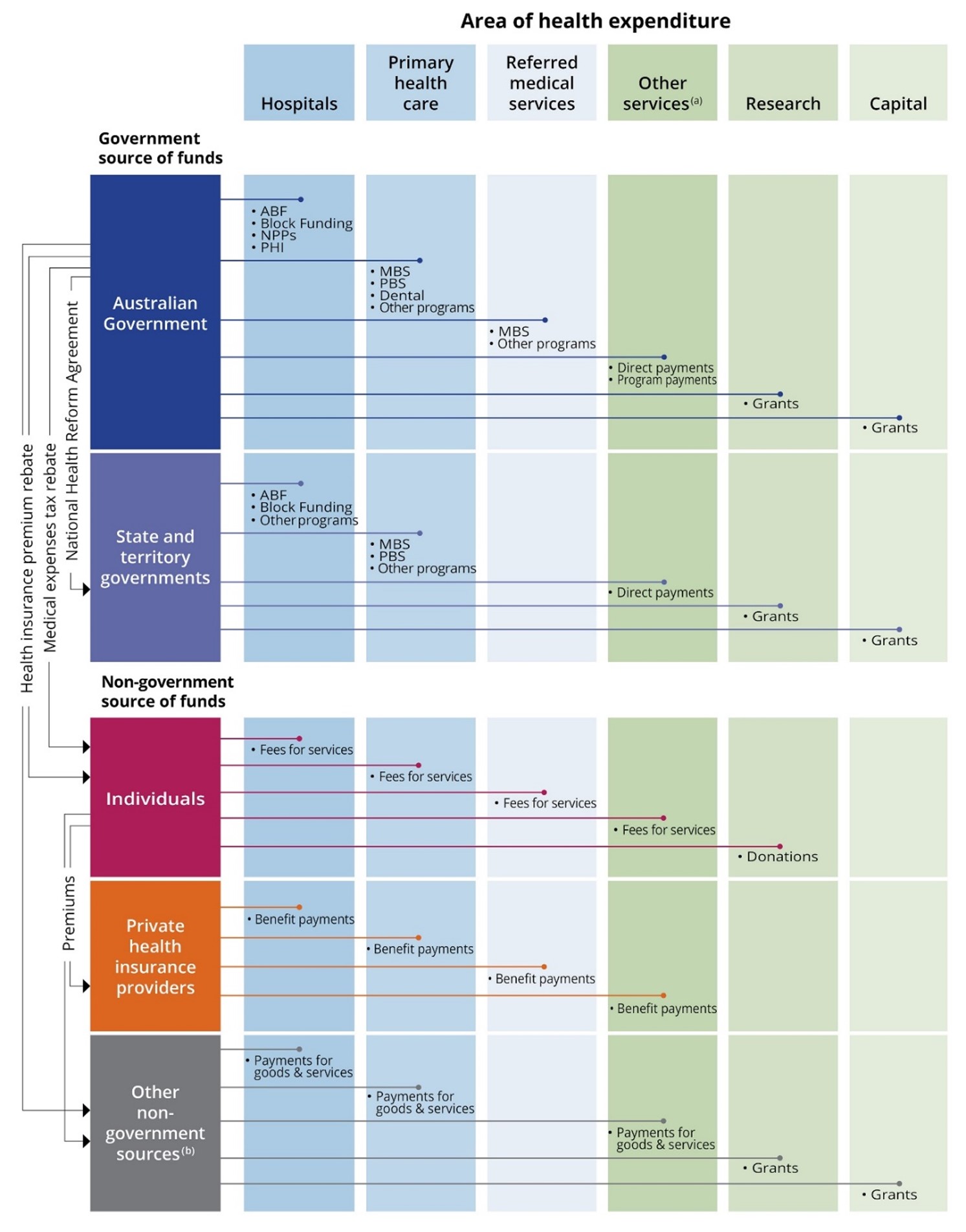The Australian National Health Account
On this page:
Overview
The Australian National Health Account (ANHA) is an annual financial-year estimate of health expenditure in Australia, produced by the AIHW. It is published in the Health expenditure Australia (HEA) report series as well as forming the basis of Australia’s submission to the Organisation for Economic Cooperation and Development and World Health Organisation annual health accounts collection.
Health expenditure is defined as spending on health goods and services, which includes medical care (both in and out of hospital); pharmaceuticals; public health; rehabilitation; community health activities; health administration and regulation; health research; and capital formation.
The estimate of health expenditure reported in HEA provides information disaggregated by both funding source and area of health spending, reflecting the structure of funding in the Australian health system (Figure 32).
Broadly, HEA presents the latest expenditure information, as well as trends for:
- the total amount spent on health in Australia, in current and constant prices
- the amount spent by the source of fundings including Australian Government, state and territory governments and non-government sources
- the amount spent on different types of health goods and services (“areas of expenditure”), such as hospitals, primary health care, referred medical services, health and medical research and capital expenditure.
The AIHW has been reporting on health spending for more than three decades. However, measuring health expenditure in Australia first began in the 1970s. A history of health expenditure data development in Australia can be found in Australian national health and welfare accounts: concepts and data sources (AIHW 2003).
Other health expenditure estimates
The ANHA aims to support a long term, whole-of-system understanding of national health spending, and where possible classifies health expenditure in terms of the Organisation for Economic Co-operation and Development’s system of health accounts (OECD SHA) categories (AIHW 2003). The 3 key dimensions of the OECD SHA classification system are health care by functions of care; providers of health care services; and health care financing scheme.
There are other estimates of health funding and expenditure in Australia, including those produced by the Australian Bureau of Statistics (ABS). There are also sources of data from specific funding programs and bodies, such as those of the National Health Funding Body (NHFB) and large funding programs like the Medicare Benefits Scheme (MBS). However, the ANHA varies from these in a variety of ways, including its scope (other estimates tend to focus on specific funding programs, jurisdictions or time periods) and, methodology and classification system used to derive estimates.
To better understand the differences in reported estimates, refer to Comparison and alignment of Australian health expenditure estimates and Understanding the different approaches to reporting Australian health expenditure (ABS & AIHW 2019).
What is not included in the estimates
The health expenditure estimates from the ANHA do not currently include:
- some local government spending
- health spending by some non-government organisations, such as the National Heart Foundation and Diabetes Australia
- occupational health spending by non-government sources such as private enterprises
- spending on the health-care component of high-level residential care.
Education and training of health professionals and many forms of spending with an outcome that would indirectly impact health – such as the production of more nutritious food, road safety or law and order – are also not included.
Data sources
The ANHA is derived from more than 50 data sources capturing health spending by governments, individuals, insurance providers and other private sources, such as some private hospital spending and research. The expenditure estimates are collated and stored in the AIHW’s Health Expenditure Database (HED).
The data sources are discussed in detail in Data processing and listed in Table T2.
Revisions and data resubmissions
There are often revisions to previously published estimates of health expenditure, due to receipt of additional or revised data from data suppliers, or changes in estimation methods. The AIHW typically provides back-casting for any changes in the methodology or data sources. As a result, comparisons over time should be based on the estimates provided in the most recent publication.
Figure 32: The structure and funding of Australia’s health system



